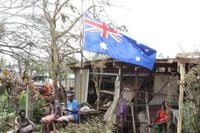On a brisk September morning in Brussels, a crowd of demonstrators gathered near the U.S. embassy, their banners and chants underscoring a crisis that has quietly unfolded across continents. The issue at hand: nearly $10 million worth of U.S.-purchased contraceptives, meant for women in Africa and other developing regions, sitting unused in Belgian warehouses. According to CNN, these supplies—ranging from copper IUDs to injectable contraceptives and vital pills—were destined for countries like Tanzania and Kenya. Instead, they risk being destroyed, a move that has sparked outrage among aid workers and women’s health advocates worldwide.
This is just one visible symptom of a much larger shift in American foreign aid policy under President Donald Trump. The Trump administration’s decision to wind down the United States Agency for International Development (USAID) in January 2025 has already had far-reaching and, according to some, catastrophic consequences. At a panel discussion in New York City on October 22, 2025, Eugene Cho, president of Bread for the World, revealed a staggering toll: “We can now look back and say without any hesitation—despite individuals in the administration saying no one has died as a result of these cuts—we can now say depending on various sources, up to 400,000 people have died as a result of these cuts.” Citing a report from The Lancet, Cho warned that if nothing changes, “by the year 2030, if nothing were to change from the shutdown of USAID, they’re estimating about 14 million people will lose their lives as a result of these shutdown programs. It also includes approximately 4.7 million children around the world.”
The abrupt closure of USAID has left gaping holes in international budgets for family planning, malaria control, HIV treatment, and child hunger. Aid workers, as reported by CNN, fear that the U.S. government may be deliberately stalling the shipment of contraceptives until their expiration, after which they could be incinerated—at a cost of $167,000—rather than delivered to those in need. This plan was temporarily blocked by regulations in Flanders, but the risk remains. Many of these products have shelf lives extending to 2028 or 2029, but import rules in recipient countries like Tanzania require that at least 60% of a drug’s shelf life remain, making prompt action urgent. “We urgently need these resources before they become unfit for import,” one aid worker stressed to CNN.
International organizations such as UNFPA have offered to purchase and distribute the supplies, but as of February 2025, Chemonics—the USAID contractor responsible for the Global Health Supply Chain Program—stopped responding to requests, further complicating the situation. UNFPA has emphasized that meeting this need could reduce maternal mortality by about 25%. The global implications are profound: more than 250 million women want to avoid pregnancy but lack access to family planning, a gap these contraceptives could help to fill.
Meanwhile, the reverberations of American policy changes are being felt far beyond the warehouses of Europe. According to the Australian Associated Press, Australia has now emerged as the largest foreign aid donor in the Pacific, stepping in as the U.S., UK, and New Zealand have scaled back their commitments. The Lowy Institute’s Pacific aid map shows that Australia’s steady aid spending and rapid expansion in infrastructure lending are expected to cushion the Pacific from the impact of major donor cuts. “Australia’s dominant role in Pacific development is expanding,” said Riley Duke, the map’s lead author. By 2028, Australia is projected to deliver more than double the combined support of Japan, New Zealand, the United States, France, Germany, and the United Kingdom.
The data tells a stark story: total official development finance in the Pacific dipped by 16% to about $5.5 billion in 2023 compared to the previous year. China, too, has shifted its approach, moving away from large, loan-financed infrastructure projects to smaller, grant-based community initiatives. While China now spends less than it did a decade ago, its aid is reaching deeper into Pacific communities, strengthening grassroots ties and, as Alexandre Dayant of the Lowy Institute notes, winning “narrative dominance” in the region. “For Australia, America’s withdrawal is more than inconvenient, it leaves Canberra increasingly alone in countering Chinese influence.”
Back in the United States, the domestic consequences of these policies are equally grave. The Trump administration has cut SNAP and WIC benefits—lifelines for millions of Americans struggling with hunger. As Eugene Cho pointed out during the New York panel, “Hunger is not a partisan issue. I believe it’s political, but it impacts people of all stripes of all states, urban, rural and what have you. And also the fact that in this country where we boast ourselves as the greatest nation in the world, that there are still 14 million children here in the United States that experience food insecurity, 42 million people on SNAP, 7 million people on WIC … .”
For faith-based organizations like HIAS US, the Trump administration’s actions have been devastating. Mark Hetfield, president of HIAS US, described how his organization lost half its revenue overnight. “On Jan. 24, we received stop work orders, orders that literally cut down half of our program with no notice, no consultation. It was a Friday afternoon. We were told effective 5:00 p.m. today, no more work with us and you’ll receive no more pay.” The administration also stopped all refugee resettlement in the United States on January 20, 2025, affecting eight out of ten faith-based agencies involved in the process. The statutory deadline for consulting Congress and issuing presidential determinations on refugee resettlement goals was missed, leaving organizations and refugees in limbo.
Moreover, the administration has redefined who qualifies as a refugee, opening a loophole to admit white Africans from South Africa while blocking 128,000 more diverse refugees with Homeland Security approval notices from entering the country. Religious minorities, including Iranian Jews, Christians, Bahais, and others, have been deprioritized, with programs providing asylum based on religious persecution halted as of January 20, 2025. “We thought religious minorities would be allowed to continue to come in to the United States as refugees,” Hetfield lamented, “but that no longer is the case.”
Defenders of the administration’s approach argue that international aid will be reconstructed in new forms, but critics remain skeptical. “Unfortunately, I don’t feel like these conversations are happening at the pace they’ve said it would or in the manner it deserves,” Cho said. The administration has also disregarded economic studies that contradict its narrative. As Hetfield recalled, “In 2017, President Trump … commissioned a study to demonstrate how much refugees cost the American taxpayer. And that study really kind of boomeranged on him because it found that when you look at both sides of the ledger, over a 10-year period, refugees and asylees contribute $63 billion more in state, local and federal taxes than they take in services and assistance.”
As the world watches, the consequences of these policy shifts continue to unfold—measured not just in dollars and statistics, but in real human lives, opportunities lost, and futures rewritten. For millions, the question remains: will help arrive before the clock runs out?

